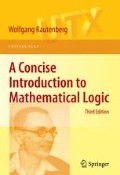Abstract
Propositional logic, by which we here mean two-valued propositional logic, arises from analyzing connections of given sentences A, B, such as
These connection operations can be approximately described by two-valued logic. There are other connections that have temporal or local features, for instance, first A then B or here A there B, as well as unary modal operators like it is necessarily true that, whose analysis goes beyond the scope of two-valued logic. These operators are the subject of temporal, modal, or other subdisciplines of many-valued or nonclassical logic. Furthermore, the connections that we began with may have a meaning in other versions of logic that two-valued logic only incompletely captures. This pertains in particular to their meaning in natural or everyday language, where meaning may strongly depend on context.
Access this chapter
Tax calculation will be finalised at checkout
Purchases are for personal use only
Notes
- 1.
Converse implication is used in the programming language PROLOG, see 4.6.
- 2.
We often use ( ∗ ) or ( ⋆ ) as a temporary label for a condition (or property) that we refer back to in the text following the labeled condition.
- 3.
This concept, stemming originally from geometry, is meaningfully defined in every algebraic structure and is one of the most important and most general mathematical concepts; see 2.1. The definition is equivalent to the condition
$$\alpha \equiv \alpha '\; \Rightarrow \; \alpha \circ \beta \equiv \alpha ' \circ \beta ,\beta \circ \alpha \equiv \beta \circ \alpha ',\neg \alpha \equiv \neg \alpha ',for \; all\alpha ,\alpha ',\beta.$$ - 4.
The disjuncts of αf can be arranged, for instance, according to the lexicographical order of the n-tuples (x1,…,xn) ∈{ 0, 1}n. If the disjunction is empty (that is, if f does not take the value 1) let αf be ⊥ (= p1 ∧¬p1). Thus, the empty disjunction is ⊥. Similarly, the empty conjunction equals ⊤ (= ¬⊥). These conventions correspond to those in arithmetic, where the empty sum is 0 and the empty product is 1.
- 5.
Unexplained notions are defined in 2.1. Our first application is interesting because in set theory the compactness theorem is weaker than the axiom of choice (AC) which is equivalent to the statement that every set can be well-ordered. Thus, the ordering principle is weaker than AC since it follows from the compactness theorem.
- 6.
Putting it crudely, this notation should express the fact that β is held to be proved from a formula set X when α and α → β are provable from X. Modus ponens is an example of a binary Hilbert-style rule; for a general definition of this type of rule see, for instance, [Ra1].
References
G. Kreisel, J.-L. Krivine, Elements of Mathematical Logic, North-Holland 1971.
W. Rautenberg, Klassische und Nichtklassische Aussagenlogik, Vieweg 1979.
G. Gentzen, The Collected Papers of Gerhard Gentzen (editor M. E. Szabo), North-Holland 1969.
H. Rasiowa, R. Sikorski, The Mathematics of Metamathematics, Warschau 1963, 3⟨{ rd}⟩ ed. Polish Scientific Publ. 1970.
B. Herrmann, W. Rautenberg, Finite replacement and finite Hilbert-style axiomatizability, Zeitsch. Math. Logik Grundlagen Math. 38 (1982), 327–344.
S. Kleene, Introduction to Metamathematics, Amsterdam 1952, 2⟨{ nd}⟩ ed. Wolters-Noordhoff 1988.
_________ , A note on completeness and maximality in propositional logic, Reports on Mathematical Logic 21 (1987), 3–8.
Author information
Authors and Affiliations
Corresponding author
Rights and permissions
Copyright information
© 2010 Springer Science+Business Media, LLC
About this chapter
Cite this chapter
Rautenberg, W. (2010). Propositional Logic. In: A Concise Introduction to Mathematical Logic. Universitext. Springer, New York, NY. https://doi.org/10.1007/978-1-4419-1221-3_1
Download citation
DOI: https://doi.org/10.1007/978-1-4419-1221-3_1
Published:
Publisher Name: Springer, New York, NY
Print ISBN: 978-1-4419-1220-6
Online ISBN: 978-1-4419-1221-3
eBook Packages: Mathematics and StatisticsMathematics and Statistics (R0)

